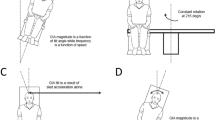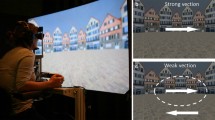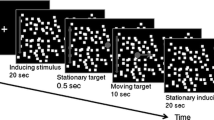Abstract
We tested the hypothesis that motion sickness is produced by an integration of the disparity between eye velocity and the yaw-axis orientation vector of velocity storage. Disparity was defined as the magnitude of the cross product between these two vectors. OVAR, which is known to produce motion sickness, generates horizontal eye velocity with a bias level related to velocity storage, as well as cyclic modulations due to re-orientation of the head re gravity. On average, the orientation vector is close to the spatial vertical. Thus, disparity can be related to the bias and tilt angle. Motion sickness sensitivity was defined as a ratio of maximum motion sickness score to the number of revolutions, allowing disparity and motion sickness sensitivity to be correlated. Nine subjects were rotated around axes tilted 10°–30° from the spatial vertical at 30°/s–120°/s. Motion sickness sensitivity increased monotonically with increases in the disparity due to changes in rotational velocity and tilt angle. Maximal motion sickness sensitivity and bias (6.8°/s) occurred when rotating at 60°/s about an axis tilted 30°. Modulations in eye velocity during OVAR were unrelated to motion sickness sensitivity. The data were predicted by a model incorporating an estimate of head velocity from otolith activation, which activated velocity storage, followed by an orientation disparity comparator that activated a motion sickness integrator. These results suggest that the sensory-motor conflict that produces motion sickness involves coding of the spatial vertical by the otolith organs and body tilt receptors and processing of eye velocity through velocity storage.









Similar content being viewed by others
References
Angelaki DE, Hess BJ (1995) Lesion of the nodulus and ventral uvula abolish steady-state off-vertical axis otolith response. J Neurophysiol 73:1716–1720
Angelaki DE, Hess BJM (1996) Three-dimensional organization of otolith-ocular reflexes in rhesus monkeys. I. Linear acceleration responses during off-vertical axis rotation. J Neurophysiol 75:2405–2424
Balaban CD (1999) Vestibular autonomic regulation (including motion sickness and the mechanism of vomiting). Curr Opin Neurol 12:29–33
Bard P (1945) Subcommittee on motion sickness; Committee on aviation medicine. In: National Research Council, National Academy of Science, Report No. 485
Benson AJ (1984) Motion sickness. Wiley & Sons, New York
Benson A (2002) Motion sickness. Office of The Surgeon General, Department of the Army, United States of America
Benson AJ, Bodin MA (1966) Interaction of linear and angular accelerations on vestibular receptors in man. Aerospace Medicine 37:144–154
Blair SM, Gavin M (1981) Brainstem commissure and control of time constant of vestibular nystagmus. Acta Otolaryngol (Stock) 91:1–8
Bles W (1988) Coriolis effects and motion sickness modeling. Brain Res Bull 15:543–549
Bles W, Kotaka S (1986) Stepping around: Nystagmus, self-motion perception and Coriolis effects. In: Keller EL, Zee DS (eds) Adaptive processes in visual and oculomotor systems. Pergamon, Oxford, pp 465–471
Bles W, Kloren T, Buchele W, Brandt T (1983) Somatosensory nystagmus: physiological and clinical aspects. Adv Oto-Rhino-Laryngol 30:30–33
Bos JE, Bles W (1998) Modelling motion sickness and subjective vertical mismatch detailed for vertical motions. Brain Res Bull 47:537–542
Bos JE, Bles W, de Graaf B (2002) Eye movements to yaw, pitch, and roll about vertical and horizontal axes: adaptation and motion sickness. Aviat Space Environ Med 73:434–436
Cheung BS, Howard IP, Money KE (1991) Visually-induced sickness in normal and bilaterally labyrinthine-defective subjects. Aviat Space Environ Med 62:527–531
Clément G, Deguine O, Parant M, Costes-Salon MC, Vasseur-Clausen P, Pavy-LeTraon A (2001) Effects of cosmonaut vestibular training on vestibular function prior to spaceflight. Eur J Appl Physiol 85:539–545
Cohen B, Helwig D, Raphan T (1987) Baclofen and velocity storage: a model of the effects of the drug on the vestibulo-ocular reflex in the rhesus monkey. J Physiol 393:703–725
Cohen B, Dai M, Raphan T (2003) The critical role of velocity storage in production of motion sickness. Ann N Y Acad Sci 1004:359–376
Cohen B, Dai M, Yakushin SB, Raphan T (2008) Baclofen, motion sickness susceptibility and the neural basis for velocity storage. Prog Brain Res 171:543–553
Cohen B, Yakushin SB, Martinelli GP, Ogorodnikov D, Flores R, Dai M, Holstein GR (2010) Blood pressure and heart rate changes from Labyrinthine stimulation in the anesthetized rat. Assoc Res Otolaryngol Abs 133
Dai M, Raphan T, Cohen B (1991) Spatial orientation of the vestibular system: dependence of optokinetic after nystagmus on gravity. J Neurophysiol 66:1422–1438
Dai M, McGarvie L, Kozlovskaya IB, Raphan T, Cohen B (1994) Effects of spaceflight on ocular counterrolling and spatial orientation of the vestibular system. Exp Brain Res 102:45–56
Dai M, Raphan T, Kozlovskaya I, Cohen B (1996) Modulation of vergence by off-vertical yaw axis rotation in the monkey: normal characteristics and effects of space flight. Exp Brain Res 111(21–29):21–29
Dai M, Klein A, Cohen B, Raphan T (1999) Model-based study of the human cupular time constant. J Vest Res 9:293–301
Dai M, Kunin M, Raphan T, Cohen B (2003) The relation of motion sickness to the spatial-temporal properties of velocity storage. Exp Brain Res 151:173–189
Dai M, Cohen B, Kaufmann H, Raphan T (2006a) Modeling how velocity storage induces motion sickness. In: Neuroscience Meeting. Neuroscience Meeting Planner, Georgia World Congress Center, Halls B3–B5, Atlanta, GA, USA
Dai M, Raphan T, Cohen B (2006b) Effects of baclofen on the angular vestibulo-ocular reflex. Exp Brain Res 171:262–271
Dai M, Raphan T, Cohen B (2007) Labyrinthine lesions and motion sickness susceptibility. Exp Brain Res 178:477–487
Darlot C, Denise P, Droulez J, Cohen B, Berthoz A (1988) Eye movement induced by off-vertical axis rotation (OVAR) at small angles of tilt. Exp Brain Res 73:91–105
Darwin E (1796) Zoonomia. J. Johnson, London
Denise P, Etard O, Zupan L, Darlot C (1996) Motion sickness during off-vertical axis rotation: prediction by a model of sensory interactions and correlation with other forms of motion sickness. Neurosci Lett 203:183–186
Donohew BE, Griffin MJ (2009) Motion sickness with fully roll-compensated lateral oscillation: effect of oscillation frequency. Aviat Space Environ Med 80:94–101
Fanelli R, Raphan T, Schnabolk C (1990) Neural network modelling of eye compensation during off-vertical axis rotation. Neural Netw 3:265–276
Furman JM, Schor RH, Schumann T (1992) Off-vertical axis rotation: a test of the otolith-ocular reflex. Ann Otol Rhinol Laryngol 101:643–650
Gizzi M, Raphan T, Rudolph S, Cohen B (1994) Orientation of human optokinetic nystagmus to gravity: a model based approach. Exp Brain Res 99:347–360
Golding JF, Benson AJ (1993) Perceptual scaling of whole-body low frequency linear oscillatory motion. Aviat Space Environ Med 64:636–640
Golding JF, Kerguelen M (1992) A comparison of the nauseogenic potential of low-frequency vertical versus horizontal linear oscillation. Aviat Space Environ Med 63:491–497
Golding JF, Arun S, Wortley E, Wotton-Hamrioui K, Cousins S, Gresty MA (2009) Off-vertical axis rotation of the visual field and nauseogenicity. Aviat Space Environ Med 80:516–521
Gordon CR, Spitzer O, Doweck I, Shupak A, Gadoth N (1996) The vestibulo-ocular reflex and seasickness susceptibility. J Vestib Res 6:229–233
Graybiel A, Wood CD (1969) Rapid vestibular adaptation in a rotary environment by means of controlled head movements. Aerosp Med 40:638–643
Graybiel A, Miller EF 2nd, Homick JL (1975) Individual differences in susceptibility to motion sickness among six Skylab astronauts. Acta Astronaut 2:155–174
Graybiel A, Miller EF, Homick JL (1977) Experiment M-131. Human vestibular function. In: Johnston RS, Dietlein LF (eds) Biomedical results from Skylab. Section II. US Government Printing Office (NASA SP-77), Washington D.C, pp 74–103
Guedry FE (1965) Orientation of the rotation axis relative to gravity: its influence on nystagmus and the sense of rotation. Acta Otolaryngol 60:30–48
Guedry FE (1974) Psychophysics of vestibular sensation. In: Kornhuber HH (ed) Handbook of sensory physiology, vol 6. Springer, Berlin, Heidelberg, New York, pp 3–154
Guedry FE, Benson AJ (1978) Coriolis cross-coupling effects: Disorienting and nauseogenic or not? Aviat Space Environ Med 49:29–35
Haslwanter T, Jaeger R, Mayr S, Fetter M (2000) Three-dimensional eye-movement responses to off-vertical axis rotations in humans. Exp Brain Res 134:96–106
Hecht H, Kavelaars J, Cheung CC, Young LR (2001) Orientation illusions and heart-rate changes during short-radius centrifugation. J Vest Res 11:115–127
Hettinger JL, Berbaum KS, Kennedy RS, Dunlap WP, Nolan MD (1990) Vection and simulator sickness. Military Psychol 2:171–181
Hoffer ME, Gottshall K, Kopke RD, Weisskopf P, Moore R, Allen KA, Wester D (2003) Vestibular testing abnormalities in individuals with motion sickness. Otol Neurotol 24:633–636
Holstein GR, Martinelli GP, Cohen B (1999a) Ultrastructure of GABA-immunoreactive vestibular commissural neurons related to velocity storage in the monkey. Neuroscience 93:171–181
Holstein GR, Martinelli GP, Wearne S, Cohen B (1999b) Ultrastructure of vestibular commissural neurons related to velocity storage in the monkey. Neuroscience 93:155–170
Igarashi M, Kobayashi K (1985) Space motion sickness and space vestibulology. J Uoeh 7(Suppl):228–236
Irwin J (1881) The pathology of sea-sickness. Lancet 2:907–909
Johnson WH, Sunahara FA, Landolt JP (1999) Importance of the vestibular system in visually induced nausea and self-vection. J Vestib Res 9:83–87
Katz E, de Jong JMBV, Büttner-Ennever JA, Cohen B (1991) Effects of midline medullary lesions on velocity storage and the vestibulo-ocular reflex. Exp Brain Res 87:505–520
Kucharczyk J, Stewart DJ, Miller AD (1991) Nausea and vomiting, recent research and clinical advances. CRC Press, Boca RatonAnn Arbor, Boston, London
Kushiro K, Dai M, Kunin M, Yakushin SB, Cohen B, Raphan T (2002) Compensatory and orienting eye movements induced by off-vertical axis Rotation (OVAR) in monkeys. J Neurophysiol 88:2445–2462
Lackner JR, DiZio P (2009) Angular displacement perception modulated by force background. Exp Brain Res 195:335–343
Lackner JR, Graybiel A (1986) The effective intensity of Coriolis, cross-coupling stimulation is gravitoinertial force dependent: implications for space motion sickness. Aviat Space Environ Med 57:229–235
Matsnev EI, Yakovleva IY, Tarasov IK, Alekseev VN, Kornilova LN, Mateev AD, Gorgiladze GI (1983) Space motion sickness: phenomenology, countermeasures, and mechanisms. Aviat Space Environ Med 54:312–317
McCauley ME, Royal JW, Wylie CP, O’Hanlon JF, Mackie RR (1976) Motion sickness incidence: Exploratory studies of habituation, pitch and roll and the refinement of a mathematical model. In: vol 39, Santa Barbara, California, Human Factors Research, Inc; Technical Report 1733-2
Money KE (1981) Biological effects of space travel. Can Aeronaut Space J 27:195–201
O’Hanlon JF, McCauley ME (1974) Motion sickness incidence as a function of the frequency of acceleration of vertical sinusoidal motion. Aerospace Med 45:366–396
Oman CM (1982) A heuristic mathematical model for the dynamics of sensory conflict and motion sickness. Acta Otolyryngol (Suppl.)392:1–44
Putcha L, Berens KL, Marshburn TH, Ortega HJ, Billica RD (1999) Pharmaceutical use by U.S. astronauts on space shuttle missions. Aviat Space Environ Med 70:705–708
Raphan T, Schnabolk C (1988) Modeling slow phase velocity generation during off-vertical axis rotation. Ann NY Acad Sci 545:29–50
Raphan T, Sturm D (1991) Modelling the spatiotemporal organization of velocity storage in the vestibuloocular reflex by optokinetic studies. J Neurophysiol 66:1410–1420
Raphan T, Dai M, Cohen B (1992) Spatial orientation of the vestibular system. Ann N Y Acad Sci 656:140–157
Reason JT, Brand JJ (1975) Motion sickness. Academic Press, London
Reisine H, Raphan T (1992) Neural basis for eye velocity generation in the vestibular nuclei during off-vertical axis rotation. Exp Brain Res 92:209–226
Schnabolk C, Raphan T (1992) Modelling 3-D slow phase velocity estimation during off-vertical axis rotation (OVAR). J Vest Res 2:1–14
Shupak A, Kerem D, Gordon C, Spitzer O, Mendelowitz N, Melamed Y (1990) Vestibulo-ocular reflex as a parameter of seasickness susceptibility. Ann Otol Rhinol Laryngol 99:131–136
Solomon D, Cohen B (1992a) Stabilization of gaze during circular locomotion in light; I. Compensatory head and eye nystagmus in the running monkey. J Neurophysiol 67:1146–1157
Solomon D, Cohen B (1992b) Stabilization of gaze during circular locomotion in darkness; II. Contribution of velocity storage to compensatory eye and head nystagmus in the running monkey. J Neurophysiol 67:1158–1170
Sturm D, Raphan T (1988) Modelling the three dimensional structure of velocity storage in the vestibulo-ocular reflex (VOR). In: IEEE Proceedings of Northeast Bioengineering
Sugita-Kitajima A, Koizuka I (2009) Somatosensory input influences the vestibulo-ocular reflex. Neurosci Lett 463:207–209
Thornton WE, Uri JJ (1991) Oculomotor function during space flight and susceptibility to space motion sickness. Acta Astronaut 23:53–61
Ventre-Dominey J, Luyat M, Denise P, Darlot C (2008) Motion sickness induced by otolith stimulation is correlated with otolith-induced eye movements. Neuroscience 155:771–779
Wang SC, Chinn HI (1956) Experimental motion sickness in dogs. Importance of labyrinth and vestibular cerebellum. Am J Physiol 185:617–623
Wearne S, Raphan T, Cohen B (1996) Nodulo-uvular control of central vestibular dynamics determines spatial orientation of the angular vestibulo-ocular reflex (aVOR). Ann NY Acad Sci 781:364–384
Wearne S, Raphan T, Cohen B (1997) Contribution of vestibular commissural pathways to velocity storage and spatial orientation of the angular vestibuloocular reflex. J Neurophysiol 78:1193–1197
Wearne S, Raphan T, Cohen B (1998) Control of spatial orientation of the angular vestibuloocular reflex by the nodulus and uvula. J Neurophysiol 79:2690–2715
Wood SJ (2002) Human otolith-ocular reflexes during off-vertical axis rotation: effect of frequency on tilt-translation ambiguity and motion sickness. Neurosci Lett 323:41–44
Yates BJ (1992) Vestibular influences on the sympathetic nervous system. Brain Res Rev 17:51–59
Yates BJ, Miller AD (1998) Physiological evidence that the vestibular system participates in autonomic and respiratory control. J Vest Res 8:17–25
Yates BJ, Jian BJ, Cotter LA, Cass SP (2000) Responses of vestibular nucleus neurons to tilt following chronic bilateral removal of vestibular inputs. Exp Brain Res 130:151–158
Yokota JI, Reisine H, Cohen B (1992) Nystagmus induced by electrical microstimulation of the vestibular and prepositus hypoglossi nuclei in the monkey. Exp Brain Res 92:123–138
Young LR, Henn V (1975) Nystagmus produced by pitch and yaw rotation of monkey about non-vertical axes. Forfshr Zool 23:235–246
Young LR, Hecht H, Lyne L, Sienko K, Cheung C, Kavelaars J (2001) Artificial gravity: head movements during short-radius centrifugation. Acta Astronautica 49:215–226
Acknowledgments
DC007847, EY04148, and DC005204. We thank Dmitri Ogorodnikov and Sergey Tarasenko for technical assistance.
Author information
Authors and Affiliations
Corresponding author
Appendix
Appendix
Estimation of velocity from sequential activation of otolith polarization vectors
In this appendix, we describe the conceptual organization of the velocity estimation as presented in Raphan and Schnabolk (1988) (Fig. 10a), its neural network implementation (Fanelli et al. 1990) (Fig. 10b) and predictions of the estimated Bias Eye Velocity as a function of tilt angle and velocity of rotation (Fanelli et al. 1990) (Fig. 10c). Conceptually, the model implements the estimation of the angular velocity of a rotating wave of otolith afferent activation as the gravity vector sweeps around the head during rotation (Fig. 10a). This is accomplished as a discrete implementation of a ratio of temporal to spatial derivatives. The temporal derivatives are estimated from processing differences between neural activity for a given cell (n) and a central cell that has a delayed version of the activity (Delay (T)). The spatial derivatives are estimated from differences between nearest neighbor polarization vectors.
a Model for estimation of head velocity (\( \hat{\omega } \)) during OVAR, with the pattern velocity estimation formula. b Neural network implementation of the model given in a. c Model predictions of the velocity estimation versus tilt angle for five simulated head velocities. The velocities are: 0°/s (open squares), 20°/s (closed circles), 40°/s (closed squares), 60°/s (open circles), and 80°/s (open triangles). The training tilts are 0, 30, 50, and 90°. The time delay is 0.75 s
The neural network implementation of Fig. 10b has a three-layer architecture with 16 neurons to estimate velocity. The estimate is a generalized inner product between temporal and spatial differences. This is a one-sided model, using information from one utricular macula. The difference between the left macula and the right macula estimation is due to mirror symmetry of the numbering of cells. A small leftward rotation of the left macula gives a positive estimate of head velocity, while a small leftward rotation of the right macula gives a negative estimate of head velocity. The Kn’s in the model implement a generalized inner product or bilinear form and account for the fact that the bias component of velocity due to OVAR is approximately independent of tilt angle after it has reached a normalization value.
The weights were adjusted to fit the data on Bias Velocity of head velocities of monkeys, ranging from 0 to 80°/s and tilts of the rotation axis of 0–90° in the model of Fig. 10b. There were 16 units in the input and internal layers. A periodic structure based on pairs of units denoted by A and B was chosen. Connection weights from neighboring units in the input layer converged onto two units in the internal layer. The connection weights were periodically repeated for the eight pairs of units in the internal layer, which because of this symmetry had identical characteristics. Note W11 on the solid connection to AN as well as the shaded one on the right, indicating an example of this symmetry. One such repeating structure is emphasized with the others suggested in gray. There is one output unit. The lowest level represents the equivalent acceleration of gravity on the otolith maculae. The dotted lines indicating pre-processing represent the function transforming the gravitational acceleration into otolith unit activations. The input layer represents the central projections of the otolith units as well as their delayed counterparts.
The key conclusion from this model is that the estimator predicts that the bias eye velocity normalizes at about 30° of tilt (Fig. 10c). For angles of tilt >30°, the estimation increases with rotational velocity and tends to saturate at about 60°/s, where the increments in estimate are no longer proportional to angular velocity. For tilts of the rotation axis less than 30°, the gain of the estimation is small relative to stimulus velocity and a substantial rotational velocity would be necessary to reach significant bias velocities.
Rights and permissions
About this article
Cite this article
Dai, M., Sofroniou, S., Kunin, M. et al. Motion sickness induced by off-vertical axis rotation (OVAR). Exp Brain Res 204, 207–222 (2010). https://doi.org/10.1007/s00221-010-2305-4
Received:
Accepted:
Published:
Issue Date:
DOI: https://doi.org/10.1007/s00221-010-2305-4





